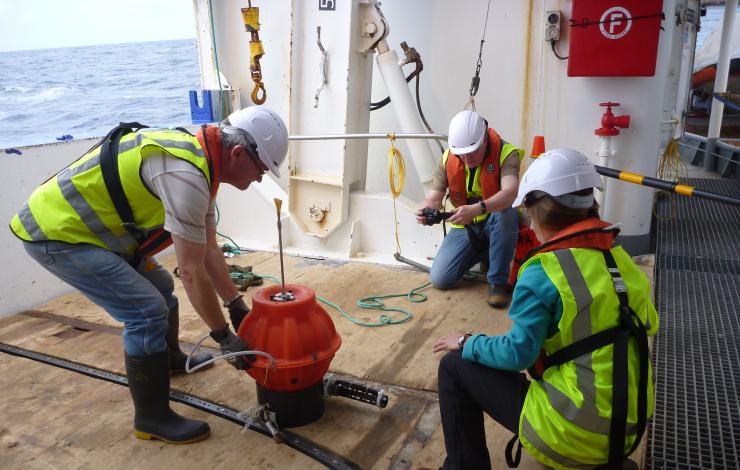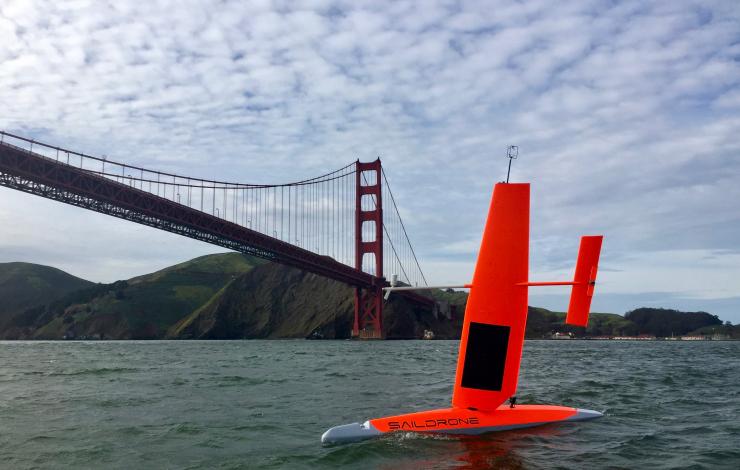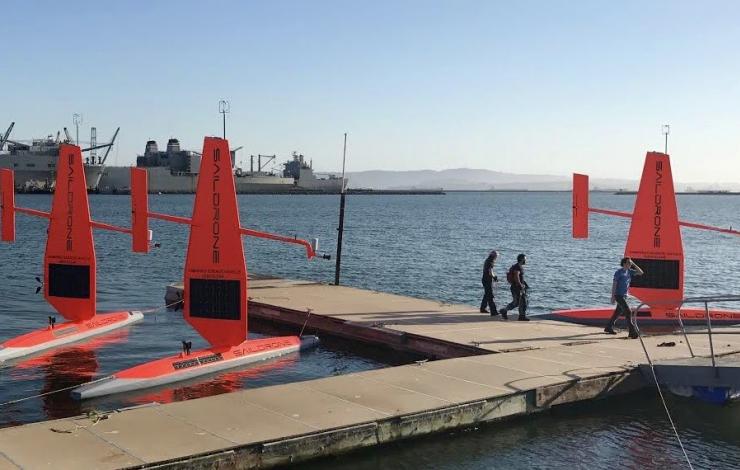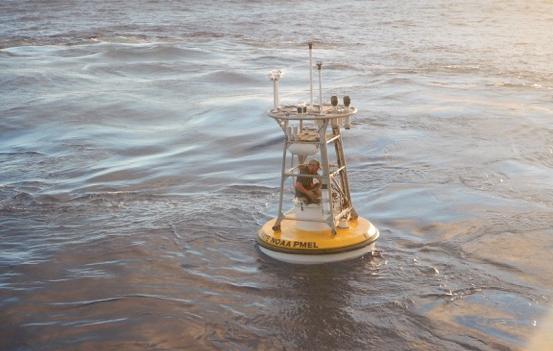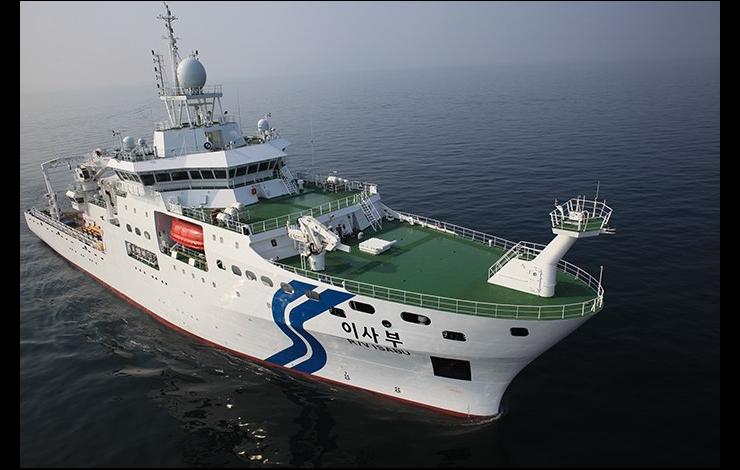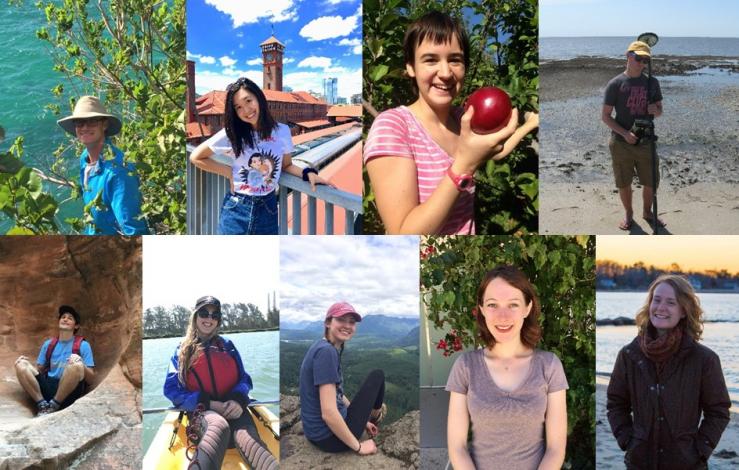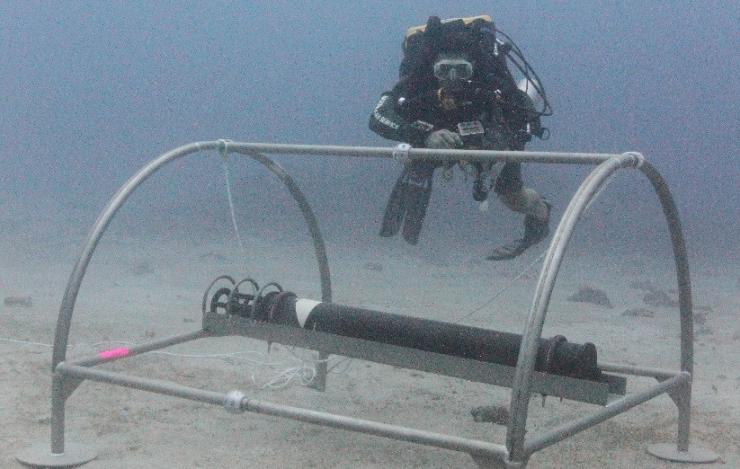What's New Archive
![]() The U.S. government is closed. This site will not be updated; however, NOAA websites and social media channels necessary to protect lives and property will be maintained. To learn more, visit commerce.gov.
The U.S. government is closed. This site will not be updated; however, NOAA websites and social media channels necessary to protect lives and property will be maintained. To learn more, visit commerce.gov.
For the latest forecasts and critical weather information, visit weather.gov.
NOAA’s Pacific Marine Environmental Lab and Paul G. Allen Philanthropies have teamed up in a groundbreaking partnership to expand Deep Argo ocean observations to improve our understanding of weather, climate and potential improve prediction of sea level rise. Deep Argo expands on the success of the Argo array but will dive up to 6,000 meters or 3.7 miles to collect data on temperature and salinity up in the lesser understood bottom half of the ocean.
“Putting Deep Argo floats in the western South Atlantic is another step toward a global Deep Argo array, which will illuminate key portions of our changing oceans,” said Gregory C. Johnson, PMEL oceanographer who will lead the project. “It’s like we’ve had a candle in a dark room and now we’re going to flip on the lamp. We’ll see all the details.”
Paul G. Allen Philanthropies has committed more than $4 million for the multi-year project, Jump-Starting Deep Argo. Allen’s research vessel R/V Petrel will deploy an array of these floats in the deep international waters east of Brazil. PMEL will provide scientific expertise and ongoing support of the array.
Abyssal ocean,
modulating climate change:
Deep Argo observes.
Read NOAA’s press release here.
Read Dr. Johnson’s guest blog post on paulallen.com
Two Saildrones headed to the tropical Pacific Ocean to enhance the Tropical Pacific Observing System
On September 1, two saildrones launched from the Saildrone Inc. dock in Alameda, CA to begin their six-month, 4,000 + nautical-mile, round-trip mission to the equator to improve the Tropical Pacific Observing System (TPOS). These saildrones are a component of a broader effort to rethink the Tropical Pacific Observing System (TPOS) that supports sub-seasonal to seasonal forecasting for the US. TPOS provides real-time data used by the US and partner nations to forecast weather and climate, including El Nino. The mission will be testing if this new, enhanced tool can collect a variety of measurements at a quality that matches research ships and proven mooring technology, Tropical Atmosphere Ocean (TAO) array. If this is the case, they may become a powerful tool to provide key observations for weather forecasts.
The saildrones are headed to the California Current Ecosystem (CCE) for a short test before taking part in a larger field study with NASA at the NASA SPURS study site in the eastern Tropical Pacific. The saildrones will perform an intercomparison with the Woods Hole Oceanographic Institution’s (WHOI) buoy and collect observational date in the study site. The saildrones will also do a calibration exercise with a research ship to ensure the accuracy and quality of the measurements that are being collected. This is particularly important to scientists when testing new sensors and technologies. Then the saildrones will travel south to the equator to do intercomparisons with the TAO moorings before heading back to Alameda, CA.
If the mission is successful, the improved data collection can help improve forecasts for El Nino’s and other weather phenomena that develop in the tropical Pacific and strongly impact North American weather patterns.
Read more about the Saildrone missions in the Arctic and the Tropical Pacific here.
Watch the launch on CBS San Francisco here.
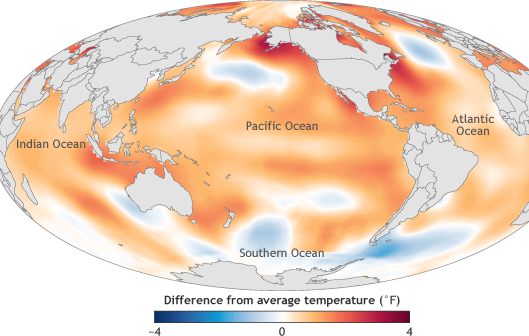
The image is of ocean surface temperature in 2016 compared to the 1981-2010 average. Despite the weakening 2015/16 El Niño event in 2016, the global average sea surface temperature in 2016 beat 2015 as the warmest year on record by a narrow margin. Image credit: NOAA Climate.gov map, adapted from Figure 3.1a in State of the Climate in 2016.
On August 10th, the State of the Climate in 2016 was published in a special edition of the Bulletin of the American Meteorological Society. This 27th annual report is based on contributions from more than 500 scientists representing over 60 countries around the world. It is the most comprehensive annual summary of Earth’s climate and provides a detailed update on global climate indicators, notable weather events and other data collected from locations on land, water, ice, and in space.
PMEL, including JISAO and JIMAR, scientists contributed to sections on the global ocean carbon cycle, ocean heat content and arctic air temperature.
The new report confirmed that 2016 surpassed 2015 as the warmest year in 137 years of recordkeeping. Several climate indicators also set new records in 2016, including greenhouse gas concentrations, sea level, and sea surface temperature. The Arctic also continued to warm with average Arctic land surface temperature 3.6°F (2.0°C) above the 1981-2010 average and sea ice extent and thickness remained low.
Dr. Gregory C. Johnson, PMEL oceanographer and editor for the ocean chapter, sums up in Haiku form:
Large El Niño wanes,
east Pacific tropics cool,
seas shed heat, slow rise
Read the full report, press release and report highlights.
Over the next four months, NOAA scientists will launch unmanned ocean vehicles, called Saildrones, from the Arctic to the tropical Pacific Ocean to help better understand how changes in the ocean are affecting weather, climate, fisheries and marine mammals. The wind and solar-powered research vehicles that resemble a sailboat will travel thousands of miles across the ocean, reaching some areas never before surveyed with such specialized technology.
Earlier this week, PMEL scientists and Saildrone, Inc. sent off three saildrones from Dutch Harbor, Alaska. For the first time, two saildrones will sail north through the Bering Strait into the Arctic Ocean to study how the Arctic Ocean is absorbing carbon dioxide. A third unmanned vehicle will survey more than 3,100 nautical miles in the Bering Sea for walleye pollock, Northern fur seals that prey on them and the elusive North Pacific right whale. This work will build on research conducted during 2016, including a study of fur seal feeding rates. NOAA Fisheries Alaska Fisheries Science Center scientists will also attach video cameras to fur seals to record feeding and verify the species and sizes of fish that fur seals are eating.
In September, scientists will launch two more unmanned systems from Alameda, Calif., on a six-month, 8,000-nautical-mile, round-trip mission to the equator to improve the Tropical Pacific Observing System (TPOS). TPOS provides real-time data used by the U.S. and partner nations to forecast weather and climate, including El Nino. The unmanned sailing vehicles will take part in a larger field study with NASA, and visit mooring sites along the array of observing buoys.
Read the release on NOAA Research here and follow along with the Innovative Technology for Arctic Exploration's Blog for the Bering and Chukchi Seas missions.
Two PMEL technicians sailed out of Yokohama, Japan aboard the M/V Bluefin on July 13th on a six-day mission to service the PMEL Ocean Climate Stations KEO mooring.
Located just south of the Kuroshio Extension Current off the coast of Japan, the KEO mooring has been in place since 2004. Equipped with meteorological and oceanographic sensors, the mooring measures the exchange of heat and moisture between the ocean and atmosphere. These exchanges affect the development of storms over the north Pacific before they reach the United States. Scientists also use the KEO data to improve hurricane predictions.
Once a year, technicians visit the site to refresh the mooring. A full set of fresh equipment is deployed. Gear that was out for the previous year is recovered, and refurbished for the following year. This has allowed the mooring to survive in very harsh conditions, providing an important climate data set for nearly 15 years.
July 2 - July 26: The Research Moored Array for African-Asian-Australian Monsoon Analysis and Prediction (RAMA) in the Indian Ocean began in 2004 as an international effort to improve understanding and ability to predict variability associated with the monsoon system. The array is now 78% complete and continues to grow through the formation of new partnerships.
The newest RAMA partnership is between NOAA and the Korea Institute of Ocean Science and Technology (KIOST). KIOST recently launched a new all purpose research vessel, the R/V Isabu, and is conducting a cruise in partnership with NOAA/PMEL to service three RAMA moorings along 67°E in throughout July 2017. Initial planning has also commenced for an Indian Ocean-Climate Workshop in Korea in late 2017 to identify common themes for a collaborative Korea-US research program over the next five years. The KIOST-NOAA Partnership is an exciting development to facilitate exchange of ideas and sharing of resources for advancing Indian Ocean science.
RAMA complements other moored buoy arrays in the Atlantic (PIRATA) and Pacific (TAO/TRITON). To learn more about RAMA, visit PMEL’s Global Tropical Moored Buoy Array’s website here.
This summer, PMEL is hosting 9 undergraduate students through the NOAA’s Ernest F. Hollings Scholarship program, NOAA’s College-Supported Internship Program at Smith College, the National Science Foundations’ Research Experience for Undergraduates, and the University of Washington’s Joint Institute for the Study of the Atmosphere and Ocean (JISAO) internship program. They are working across multiple groups at PMEL: Acoustics, Earth Ocean Interactions, Atmospheric Chemistry, Ocean Acidification, Madden-Julian Oscillation (MJO), and Large Scale Ocean Physics. The students spend 10 weeks at PMEL with their mentors getting hands-on research experience at both the Seattle and Newport locations. They are all so passionate and can't wait to see what they accomplish this summer.
This year's cohort are: Will Christian from Michigan Technological University, Tina Chen from Middlebury College, Max Garvue from University of Nebraska - Lincoln, Nick Barber from Drexel University, Danielle Naiman from the University of California - San Diego, Gabby Kalbach from California State University - Monterey Bay, Sophie Shapiro and Courcelle Stark from Smith College, Emily van Auken from Stonehill College. Read more about each of them and their projects here.
Learn more about NOAA’s Ernest F. Hollings (Hollings) Undergraduate Program, the National Science Foundation Research Experience for Undergraduate (NSF-REU) program, JISAO summer intership program, and the NOAA College-Supported Internship Program.
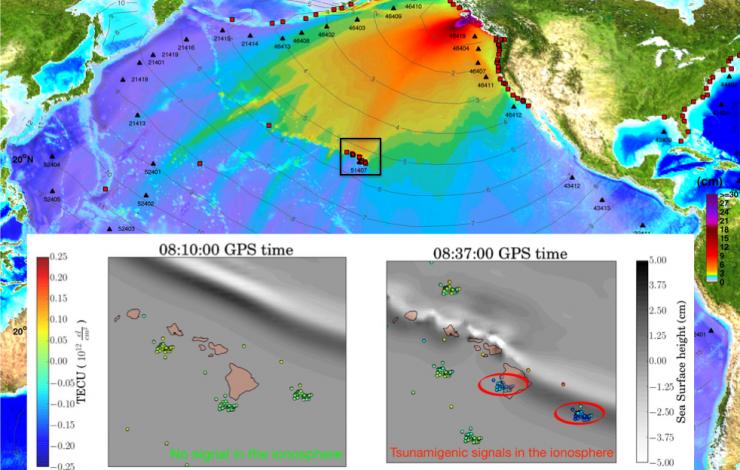
Maximum wave amplitude for the October 28, 2012 Haida Gwaii Tsunami computed with the MOST forecast model. The insets show the space-time TEC variations at 2 epochs within 27 mins interval (08:10 to 08:37 UT - October 28, 2012) at the sub-ionospheric points for 5 satellites showing TIDs, overplotted the tsunami MOST model. The TIDs are consistent in time and space with the tsunami waves.
Tsunamis can produce gravity waves that propagate up to the ionosphere, is a region of the Earth’s atmosphere where there is a high concentration of ions and electrons that can affect the spread of radio waves. These ionospheric disturbances can be studied in detail using ionospheric total electron content (TEC) measurements collected by continuously operating ground-based receivers, for example GPS, from the Global Navigation Satellite Systems (GNSS).
The existing tsunami warning system developed by the NOAA Center for Tsunami Research (NCTR) at PMEL currently relies on numerical modeling MOST (Method of Splitting Tsunami model) and buoy observations to produce timely and accurate tsunami forecast for potentially vulnerable U.S. coastal communities. Ground GNSS observations processed in real-time may have the potential to enhance the current system by independently providing the tsunami speed and amplitude.
In a study published in Scientific Reports, the authors present results using a new open-source approach named VARION (Variometric Approach for Real-Time Ionosphere Observation) that focuses on the real-time detection of the Traveling Iononspheric Disturbances (TIDs) caused by tsunami atmospheric gravity waves. This method, combined with real-time data from different sources (e.g. seismometers, buoys, GNSS receivers), may be considered as a novel contribution to future integrated operational tsunami early warning system.
This study was a collaboration among the University of Rome, NASA JPL, NCTR and the University of Washington. Dr. Yong Wei from NCTR and UW’s Joint Institute for the Study of the Atmosphere and Ocean provided MOST modeling of tsunami waves near Hawaiian Islands, more than 4,000-km away from the tsunami source, generated by the October 28, 2012 Haida Gwaii earthquake. The model/data comparison shows the TIDs are very consistent in time and space with the model simulated tsunami waves, offering insight with regard to the ionospheric response to the tsunami-driven atmospheric gravity wave.
May 16-June 2: The second summer field season for the Arctic Heat Open Science Experiment began with its first flight out of Kotzebue, Alaska. The research team, including Kevin Wood, are flying aboard a specially-outfitted NOAA Twin Otter aircraft to launch traditional atmospheric and oceanographic probes as well as the experimental Air-Launched Autonomous Micro-Observer (ALAMO) floats into the Chukchi Sea. After last year's field missions, two ALAMO floats made it through the winter and are currently profiling every 5 days. Check out the raw data for float 9085 and float 9076.
Arctic Heat is an open science experiment, publishing data generated by the project to further NOAA Science Missions with real-time data to facilitate timely observations for use in weather and sea-ice forecasts, to make data readily accessible for model and reanalysis assimilation, and to support ongoing research activities across disciplines.
Arctic Heat is a joint effort of NOAA Pacific Marine Environmental Laboratory (PMEL) Arctic Research, the Innovative Technology for Arctic Exploration (ITAE) program, the ALAMO development group at the Woods Hole Oceanographic Institution (WHOI), and the Joint Institute for the Study of the Atmosphere and Ocean (JISAO) at the University of Washington.
This week, the US Virgin Island National Park will deploy the 12th Noise Reference Station in the National Park. PMEL's Acoustic program built the hydrophone and provided the instrumentation and software. Identical hydrophones have been deployed at the other reference stations to ensure consistency across the data sets. Data collected by the NOAA Ocean Noise Reference Station Network contributes to national monitoring efforts and assesses potential noise impacts on marine resources, including endangered marine mammals and fish. This Noise Reference Station is part of a large-scale effort to monitor long-term changes and trends in underwater sound across U.S. water. The network of stations provide fundamental data to understand what ambient ocean sound levels are now, how they're changing over time and how man-made noise, such as from shipping, may be impacting marine life. The locations of the network range from as far north as the Arctic coast of Alaska to American Samoa in the South Pacific.
This project is a collaboration with a variety of partners, including NOAA’s National Ocean Service (NOS), NOAA’s National Marine Fisheries Services Science Centers, NOS National Marine Sanctuary System, and Department of the Interior’s National Park Service. For more information on this collaborative project, see NOAA/PMEL Ocean Noise Reference Station Network, and the NOAA/NMFS-OST feature story.



